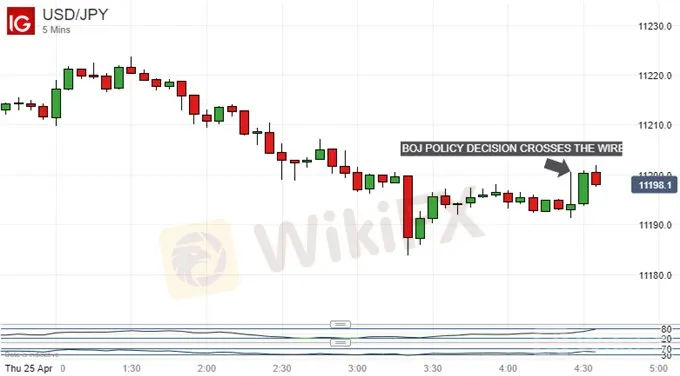简体中文
繁體中文
English
Pусский
日本語
ภาษาไทย
Tiếng Việt
Bahasa Indonesia
Español
हिन्दी
Filippiiniläinen
Français
Deutsch
Português
Türkçe
한국어
العربية
Japanese Yen Takes BoJ Growth Call Cut In Stride, Policy Settings Held
Abstract:The Japanese Yen was steady as the BoJ left its monetary settings alone and cut forecasts for both growth and inflation yet again.
Japanese Yen, Bank of Japan Monetary Policy Decision, Talking Points:
The BoJ left its policy settings alone as expected
It cut growth and inflation forecasts however
The Yen is likely to lack domestic policy support for the foreseeable future
Join our analysts for live, interactive coverage of all major economic data at the DailyFX Webinars. Wed love to have you along.
The Japanese Yen remained under broad pressure Thursday as the Bank of Japan left all its monetary policy setting unchanged and committed monetary easing as it downgraded growth forecasts.
That means that the key short-term rate stays at -0.1%, the ten-year Japanese Government Bond yield target is 0.0%. The BoJ also revised its 2019 GDP growth call for the current fiscal year down to 0.8%, from 0.9% with a similar-sized cut to next years forecast which is now 0.9%.
In a statement the BoJ also said that interest rates will remain at low levels for an extended period and, interestingly, ‘at least’ through until spring of next year.
The central bank has been striving for years to stoke some pricing power in Japan but, despite massive, unprecedented stimulus, inflation remains stubbornly low. The BoJ remains publicly committed to its target of getting consumer price rises sustainably up to an annualized rate of 2%; the current rate is just 0.5%.
Indeed, core CPI forecasts were trimmed again with the BoJ now only seeing a rate of 1.4% by the end of fiscal 2020/21, from 1.5% before.
It certainly seems highly unlikely that inflation will be durably back to target by next spring, so market debate will no doubt focus on whether the BoJ means that policy could be tightened then regardless, or whether- and more probably- that low rates will simply be extended.
Moreover the BOJ did indulge in some de facto monetary tightening just last week, when it cut its monthly asset purchase target to JPY160 billion ($1.43 billion) per month, from its previous total of JPY180 billion. If this process continues focus could well grow on that inflation target, and the possibility that it could be changed even if inflation does not rise as worries about the effects of such long-term monetary accommodation grow.
USD/JPY had been drifting lower through the session and the BoJ‘s announcement didn’t stop that process, coming in largely as expected.

However, on its daily chart the Japanese Yen remains utterly defensive against the US Dollar. Despite plentiful economic uncertainties global risk appetite is holding up remarkably well, supported in turn by reasonable corporate earnings out of the US and enduring hopes for a trade settlement between China and the US.
The US Dollar retains a massive yield advantage over Japan, even as the markets move to price in a more cautious Federal Reserve through the remainder of 2019.

Healthy risk appetite tends to weigh heavily on the Japanese Yen as it often prompts investors in Japan to seek better returns elsewhere.
USD/JPY is now flirting with the top of a trading range which encompasses the last significant peak, that of late February and early March. It guards the way higher to the tops of late 2018, which seem likely to be tested once again in due course should that risk appetite hold up.
Disclaimer:
The views in this article only represent the author's personal views, and do not constitute investment advice on this platform. This platform does not guarantee the accuracy, completeness and timeliness of the information in the article, and will not be liable for any loss caused by the use of or reliance on the information in the article.
Read more

Global Market Volatility Amid Central Bank Decisions and Corporate Earnings
The global market is experiencing significant volatility due to uncertainties in economic data and central bank policies. Key highlights include the Nasdaq 100 index's dramatic rise and fall, Amazon's disappointing sales data, and Japan's significant stock market drop following an unexpected rate hike by the Bank of Japan.

Dollar Gains on Hawkish Fed Outlook
After digesting Jerome Powell's comments following the FOMC interest rate decision on Wednesday, the dollar erased all its losses from the soft CPI reading, continuing its upward trajectory. The hawkish outlook from the Fed stimulated dollar strength against its peers, while the bullish momentum in equity markets was hindered by the prospect of prolonged high interest rates.

USDJPY Predicted to Rise on Yen Depreciation
The USD/JPY pair is predicted to increase based on both fundamental and technical analyses. Fundamental factors include a potential easing of aggressive bond buying by the Bank of Japan (BoJ), which could lead to yen depreciation. Technical indicators suggest a continuing uptrend, with the possibility of a correction once the price reaches the 157.7 to 160 range.

GEMFOREX - weekly analysis
The week ahead: Top 5 things to watch
WikiFX Broker
Latest News
Brazilian Man Charged in $290 Million Crypto Ponzi Scheme Affecting 126,000 Investors
Become a Full-Time FX Trader in 6 Simple Steps
ATFX Enhances Trading Platform with BlackArrow Integration
Decade-Long FX Scheme Unravels: Victims Lose Over RM48 Mil
What Can Expert Advisors Offer and Risk in Forex Trading?
5 Steps to Empower Investors' Trading
How to Find the Perfect Broker for Your Trading Journey?
The Top 5 Hidden Dangers of AI in Forex and Crypto Trading
The Most Effective Technical Indicators for Forex Trading
Indian National Scams Rs. 600 Crore with Fake Crypto Website
Currency Calculator






